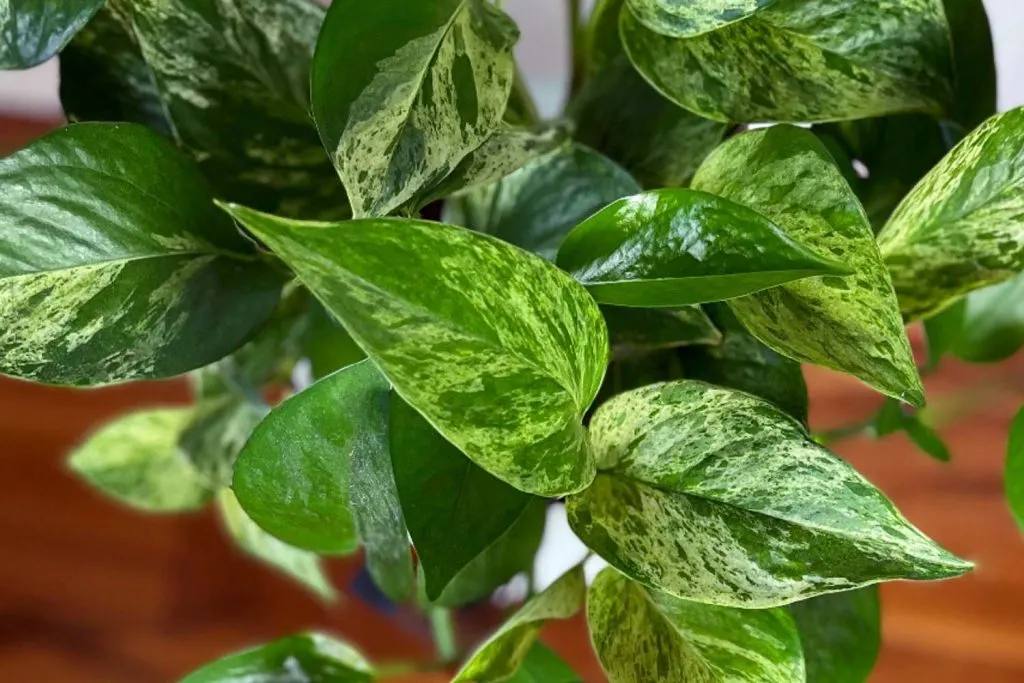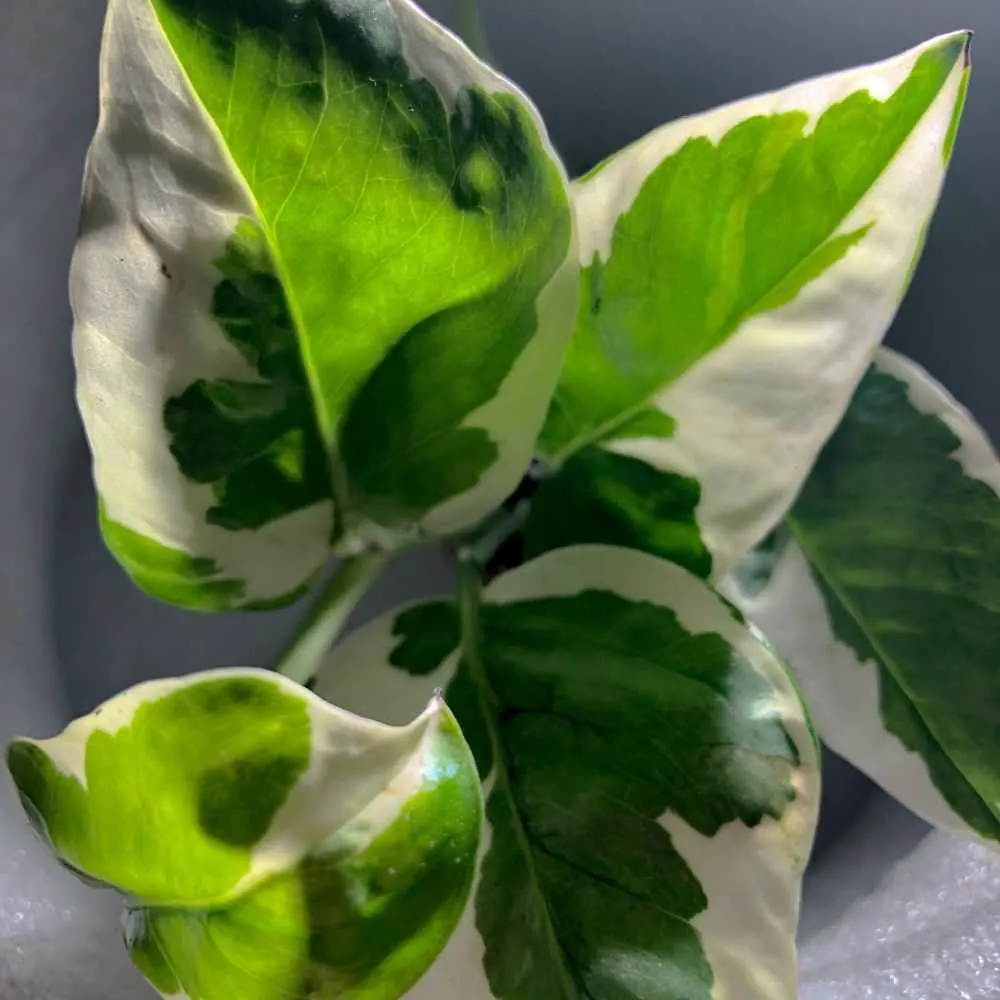Pothos plants are extremely hardy and beautiful aroids that grow as vines. The different varieties express unique variations in leaf texture, color and size.
Pothos is known in various parts of the world as Devils ivy, Ceylon creeper, hunter’s robe, ivy arum, money plant, silver vine, Solomon Islands ivy, and taro vine.
All these common names prove the point. Epipremnum aureum are found all over the world. They well loved (and sometimes hated when they go wild).
These lovely vines can handle a wide range of conditions.
They always make great easy care houseplants. The Devil’s Ivy moniker stuck since they are so hard to kill. Give one as a plant gift to a beginner plant parent. You can’t go wrong with a Pothos.
How Long will Pothos grow? Pothos plants grow leafy trailers that extend up to 40 feet long in native outdoor conditions. As a houseplant this vine typically reaches a length of 8 to 10 feet long.
This Post covers how to grow and train Pothos plants. Our quick care table and our longer printable care guide offer guidance to keep this plant at its best.

Pothos Varieties:
All Pothos have beautiful foliage. These long vines are available in several variegation patterns. Different varieties have leaves.
Some have smooth, large leathery heart shaped green leaves. Others are rumpled. Some are various shades of green. Most have variegations of some sort. The leaves are what it’s all about with this plant.
There are several varieties like the Pothos N’Joy, Pearls and jade and Manjula with slightly rumpled, twisted leaves.

The Satin is the only Devils Ivy with fuzzy leaves and splash variegation.

Hunter’s Robe plants are jewels in your home. These vines will thrive in conditions punishing for other fussier plants. Here are three of our favorite Pothos varieties.
How Many Varieties Of Pothos are there? Around 15 different varieties of this easy care house plant are available for purchase. The Golden pothos is the most well known and commercially available.
The List of Pothos Varieties:
Here’s a list of the varieties I found On Etsy. Some of them I have seen no where else. So many choices!
- Golden
- Marble Queen
- Neon
- Pearls and Jade
- Pothos N’Joy
- Manjula
- Snow Queen
- Jessenica
- Cebu Blue
- Satin or Silver-Scindapsus
- Jade-solid green
- Harlequin
- Global Green
- Hawaiian – This one has HUGE leaves and will grow like wildfire.
- Glacier
The rarest varieties are the Harlequin, Glacier, Jade, Global Green and Hawaiian.
Fortunately you will find a LOT of the more common Pothos in your local garden shops year round. It’s hard to choose a favorite. I have several types of Pothos in my plant collection. I love each of them for different reasons.
All Pothos plants are extremely hardy and beautiful. They each have unique variations in texture, color and leaf size.
They make very versatile indoor plants given the wide range of conditions they can flourish in.



Find All Of Our Pothos Care Guides and Information Posts Here
All the pothos plants make excellent indoor plants or container plants for a warm climate patio. They are very tolerant of neglect and will thrive when cared for properly.
And they do even more for their plant parents.
Does Pothos Clean The Air?
Do Pothos Filter the Air? NASA’S Clean Air Study place Pothos high on their list of air filtering plants. Pothos effectively filter out benzene, formaldehyde, xylene, toluene and carbon monoxide from your indoor spaces.
With that noted, no houseplant can be expected to clean every toxin from your indoor spaces. Unfortunately, our homes now have a LOT of toxins in them from our home furnishings and construction materials.
NASA recommends two or three air filtering plants in 8 to 10-inch pots for every 100 square feet of air space. That translates into a LOT of greenery hanging about the place.
Plants like pothos are certainly a PART of the solution for removing home toxins, but they cannot do the whole job by themselves.
Plants and people go together. Live greenery is therapeutic for humans and Improves our Home Environment.

Care and Growing Tips:
Pothos Quick Care Tips:
| Familiar Names: | Pothos, devils ivy, hunter’s robe, Ceylon creeper, ivy arum, money plant, silver vine, Solomon Islands ivy, and taro vine. |
| Scientific Name: | Epipremnum aureum |
| Plant Family: | Araceae |
| Care Difficulty: | Easy |
| Temperature Range: | 65 to 85 degrees F. |
| Watering Needs: | Water when the soil is dry down to the root zone. Soak and drain well. |
| Soil Type: | Light, Friable, well draining soil of potting mix and perlite is best. OR these plants grow well in LECA. Read our Post Series on Growing Plants in LECA. |
| Lighting: | moderate to bright Indirect light |
| Growth: | Pothos grow as trailing vines. Train either upward or let hang. |
How Often Do You Water A Pothos Plant?
Water Pothos once weekly or bi-weekly. However, Don’t let the calendar be your guide. Before watering check the soil and look for signs of plant health. Water when the pot is dry down to the root zone. I use a moisture meter to check the soil but a finger inserted into the soil will also work.
Watering Tips:
- These vines enjoy humidity but can live happily in drier indoor climates with an occasional spritz of water on the leaves.
- Overwatering shows up as yellowing or dropping leaves. If this happens, check for pests as well. If no pests or pest damage are found on the leaves you are overwatering. Overwatering invites fungus gnats and root rot. Learn how to fix root rot here and learn how to get rid of fungus gnats in this post.
- Under watering or inconsistent waterings can cause brown spots on the leaves. So can over fertilizing. Read our Guide to fertilizing for more tips.
- Dense Heavy potting soil holds a lot of water and makes proper watering difficult.
- I use Miracle grow potting mix. It works great on all my Pothos. 0.25 – 0.13 – 0.19 is the nutrient analysis. Mix it with Perlite 60/40 for a lighter mix.

What Kind Of Light do Pothos Need?
All Pothos vines enjoy moderate to bright INDIRECT light. Strong bright Direct light will burn the leaves and bleach out the leaf color. These plants will tolerate low light conditions. However, for best color in the variegated types of pothos choose moderate to bright indirect lighting.

All the pothos plants grow as trailing vines. Unless you prune them they will have just a few long trailers descending from the pot as you see below.

Read our tips and guidance below on how to grow Pothos plants as either a hanging plant or a trellised vine. Lots of options to enjoy and display these pretty, lush plants.
Can you Grow Pothos in a Hanging Basket?
Pothos vines make fantastic hanging baskets. These trailing vines will produce lushly interesting foliage that creates a lively focal point, or backdrop, in any corner with moderate indirect light.
Follow These tips for a beautiful Hanging Pothos Plant:
- Encourage new growth to grow evenly around the plant by continuing to turn the hanging basket to the light source in the room.
- Prune uneven or over long trailers.
- These vines are great candidates for planting on walls and upper shelves in bright indirect light.
- You can cut the length of the trailers and force more growth from the top that way. This will help encourage a fuller plant with more even growth.
- Put your plant in a pot with a deep drain plate under it. This allows bottom watering.
- Learn more about Bottom watering hanging plants here. It is easiest watering method for hanging plants and promotes the best root growth.
- Make sure you keep hanging plants out of doorways and other areas with extreme temperature changes.
- Avoid placing your hanging plants in places with a lot of drafts.
- Hang your Pothos plants in areas away from kids and pets.
Growing Pothos Upwards:
Growing Pothos upward works well since they climb easily. Anchor a pole or trellis into, or nearby your pot. Now attach the vine to it with twine. Your vine will grow upwards toward the light.
You may have to arrange the vine around the pole or tie it to a few points on the trellis until it grips.
Will Pothos grow up a moss pole? Pothos will enjoy growing on a moss pole. They are great vertical growers and moss poles are good choices for this climber. Learn how to grow your pothos up a moss pole here.

These vines are so pretty staked, on a trellis, climbing over a curtain rod or arranged so they grow vertically anywhere you want them.
Why Is Pothos Called Devil’s Ivy?
Pothos plants are called devil’s ivy for two reasons. Outdoors, in tropical climates like Hawaii, these vines quickly become invasive. This plant is also moderately toxic to pets and humans.

Devil’s Ivy Invasive Species Warning:
The Devil’s Ivy climbs trees and all over the ground in tropical climates. Pothos have inserted themselves into forested areas where they are not native and can harm native species. In a tropical climate, be careful when growing them outdoors. Pothos quickly get out of control.
How poisonous is Pothos?
All Pothos varieties are moderately toxic to pets and to humans. Burning mouth, vomiting and rashes may develop. This vine is a skin irritant. Wear gloves when pruning and wash your hands.
Ingesting leaves and stem of Pothos is not fatal. But medical care may be needed for a serious poisoning. If your pet or child eats part of this plant get informed and get help.
Pothos is toxic to Humans:
- Devils Ivy contains Calcium oxalate which is toxic to humans.
- Possible side effects from the consumption of E. aureum are atopic dermatitis (eczema).
- Burning and/or swelling of the region inside of and surrounding the mouth.
- Excessive contact with the plant can also lead to general skin irritation or contact dermatitis.
- If symptoms are severe or persistent call poison control or seek medical care.

What if my Cat Eat Pothos Leaves?
Cats are notorious for chewing plants. Keep Pothos away from cats, dogs and other pets that will chew them. If you see your cat ( or any pet) chewing on this plant...
- The Devils Ivy plant is toxic to cats and dogs. It is listed by the ASPCA as having Insoluble raphides.
- Keep these plants our of reach of pets.
- If plant parts are ingested look for symptoms. Symptoms include oral irritation, vomiting, and difficulty in swallowing.
- If you see symptoms of Pothos poisoning in your pet, call your vet.
Follow our printable care instructions below for the general care needs of pothos.
Pothos Plant Care Guide

Pothos have only a few basic requirements to remain a happy durable plant.
This lovely vine is a perfect beginner houseplant.
Materials
Instructions
Pothos Soil Preference:
- This aroid requires a light soil.
- A mix of potting soil and perlite will keep the roots happiest.
- Our mix for this pothos is 40 % potting mix to 60% perlite.
- A heavy soil potting mix is not recommended for aroids.
Pot Size and Type:
- Pothos vines can be grown in relatively small pots since they are fairly slow growers.
- If you want to encourage faster growth choose a pot about 2 inches wider in diameter than the current pot.
- Any well drained pot can be used. It MUST have drainage.
- Repot every second year or when roots come out the drainage holes on the pot bottom To the next pot size up.
- Don't jump to a huge pot from a small one unless you wish to encourage faster growth. Just go to the next size up pot.
Pothos Lighting Requirenments:
- The pothos vines enjoy moderate to bright indirect or dappled light. Hover, It will tolerate lower indirect light it if has some brighter moments in the day.
- The variegated types of pothos require more light to show off their colors best.
- Shield this aroid from strong direct light in summer south and west sunny windows. The leaves will burn.
- Tip: Window sheers or blinds can offset some brief periods of high direct light.
How to Water a Pothos:
- Water your Epipremnum Aureum when the soil is dry down an inch or so. Give it a good soak so all the soil is moist. Then let the pot completely drain. Pour out any water in the drain plate.
- Aroids do not like to be overly wet. Try a watering schedule of every other week. But let the plant guide you rather than the calandar.
- This tropical plant enjoys humidity. In dry climates this Pothos will thrive with a humidifier nearby. or set it in your kitchen or bathroom. For a really dry climate frequent misting will help.
- In dormant winter months reduce watering to when the soil is dry down halfway .
- Never let this plant get wet feet. If the soil is compacted the bottom of the soil can remain wet which encourages root rot and fungus gnats. If you see yellow leaves on pothos you are probably overwatering.
How to Fertilize a Pothos:
- Apply a good quality fertilizer (linked in materials) monthly through Spring and summer.
- Decrease feedings by late Fall and allow the pothos to rest through the winter months.
- Look for brown spots on the leaves of your plants. This may indicate an over concentration of salts in the roots from over feeding. It can burn the leaves.
- Read Our Post On Fertilizing plants for more information.
Temperature:
- Keep pothos at a low of 65 Degrees F. to upward of 85 Degrees F. It enjoys warmth and humidity.
Pruning and Training:
- Pruning will give you a fuller plant with more even growth. Unpruned pothos will trail.
- Sharp Hand pruners are preferred for pruning. They will give a clean cut that will heal quickly.
Table Top Plants:
- It’s easy to prune and shape these plants to whatever length and fullness you desire.
- As a table top plant cut the trailers back evenly all around the pot. If you want the pot fuller add more starts of the neon.
Pests:
- Pothos is not fussy and resists pests. However all plants can get attacked by pests.
- Stress by longterm overwatering, poor light, extreme temperatures and soil conditions are contributors to plant stress..
- Read Our Post on 7 most common plant pests and how to kill them.mites, mealy bugs, spider mites, scale, thrips and whitefly are the most common houseplant pests you will see.
- Read our post on How to get rid of aphids and other pests with our homemade pesticide soap recipe or neems oil.
- To minimize the possibility of pests be sure to check all nursery plants before bringing them home.
- Quarantine all new plants until you are sure no pests live in them.
How to Propagate:
- Propagation is easily done through leaf node stem cuttings.
- You need a 3 to 6 inch leaf stem with a couple of nodes and healthy growth.

- Place the node into a jar with water. Use tap water that has settled 24 hours in the jar to dissipate chemicals harmful to the neon.
- Set the jar in a well lit area.
- After several weeks roots will grow. Allow the roots to get an inch or more in length.
- Plant gently and firmly into pot with proper soil mix.
- Make sure to keep the soil moist until the roots begin to set into the soil. Be sure to read our post on Propagaing pothos here.
Notes
watch our video below for more on pothos care and propagation.
Follow Us:
Find us on YouTube, Instagram , Pinterest and TikTok! We love to Plant chat. We also comment, like and occasionally share your content to our daily stories. We’d love to see your plants. Share your joy in your houseplants. Happy Planting!
Related Content:
Recent Posts:
- 5 Fantastic Cactus Species for Your Home
- Pygmy Date Palm Trees
- Bromeliad Care Guide and Profile
- Growing Gloxinia Plants in Your Home
- Staghorn Ferns Care and Maintenance


Cebu Blue Pothos (Epipremnum pinnatum) - The Contented Plant
Tuesday 28th of February 2023
[…] to any space it occupies. Not only is this plant stunning, it is also relatively easy to care for. Just like its close relatives, the pothos plants. This plant is an excellent choice for beginners and experienced plant owners […]
Manjula Pothos Care Guide - The Contented Plant
Thursday 19th of May 2022
[…] The Golden Pothos […]
Pothos N Joy Plant Profile & Care Guide - The Contented Plant
Friday 6th of May 2022
[…] Pothos Plant care is easy. Read our complete Guide on Pothos […]
Arrowhead Plant Care - The Contented Plant
Tuesday 12th of April 2022
[…] Pothos, philodendrons, and monsteras, Arrowhead plants are one of the best plants for a beginner plant […]
How to care for a ZZ plant - The Contented Plant
Wednesday 30th of March 2022
[…] Pothos-Epipremnum aureum-(Devils Ivy) […]